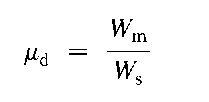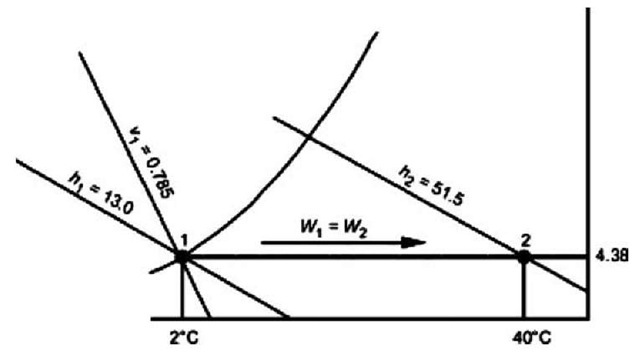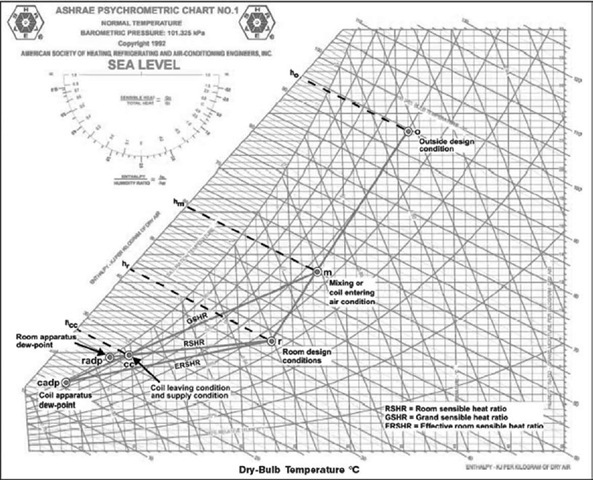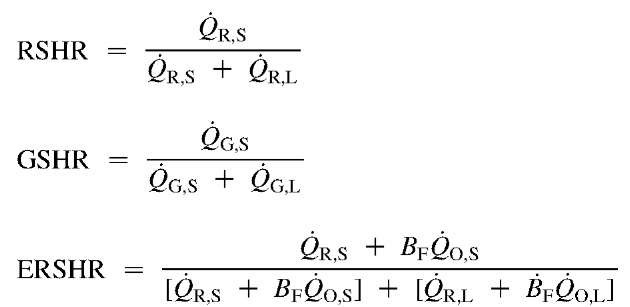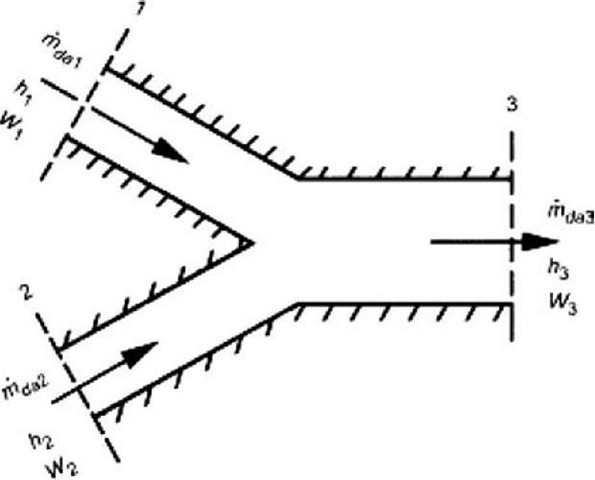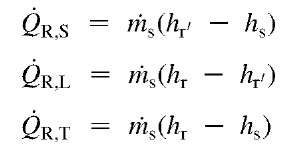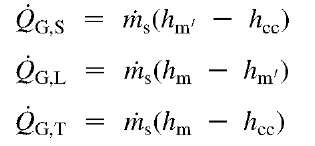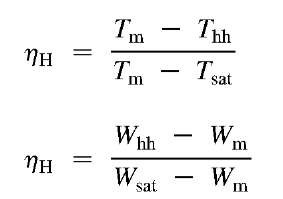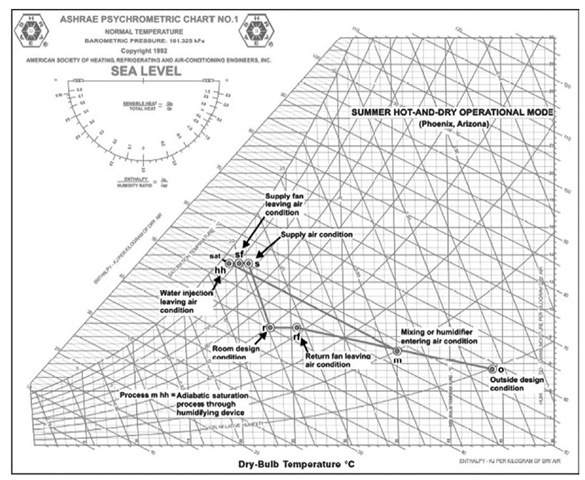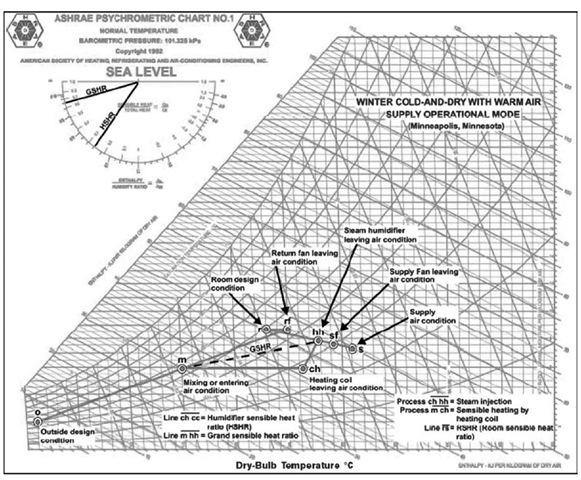Abstract
This entry presents the basics of psychometric theory. This includes a brief discussion of moist air properties and psychrometric processes as well as provides examples of how the theory may be used in the HVAC design process for different summer and winter systems.
INTRODUCTION
Psychrometrics is the science of moist air properties and processes. It is used to illustrate and analyze air conditioning cycles, translating the knowledge of the building heating or cooling loads (which are in kW or tons) into volume flow rates (in m3/s or cfm) for the air to be circulated into the duct system. The approximate composition of dry air by volume is as follows: nitrogen = 79.08%; oxygen = 20.95%; argon = 0.93%; carbon dioxide = 0.03%; other gases = 0.01%. Water vapor is lighter than dry air. The amount of water vapor that the air can carry increases with its temperature. Any amount of moisture that is present beyond what the air can carry at the prevailing temperature can only exist in the liquid phase as suspended liquid droplets (if the air temperature is above the freezing point of water) or in the solid state as suspended ice crystals (if the temperature is below the freezing point).
The most exact formulations of thermodynamic properties of moist air in the temperature range of — 100°C-200°C are based on the study performed by Hyland and Wexler.[4'5] More recent studies by Sauer et al.[8] and Nelson et al.[7] provided psychrometric data for moist air in the temperature range 200°C-320°C and humidity ratios from 0 to 1 kg/kgair at pressures of 0.07706 MPa (corresponding to an altitude of 2250 m), 0.101325, 0.2, 1.0, and 5 MPa. Both studies developed the psychrometric data using the most current values of the virial coefficients, enthalpy, and entropy of both air and water vapor. Other psychrometric data were generated by Stewart et al.,[9] who created psychrometric charts in SI units at low pressures. More psychrometric charts and tables are also available in the American Society of Heating, Refrigerating and Air-Conditioning Engineers, Inc. (ASHRAE) brochure on psychrometry.[1] Most recently, Mago and Sherif[6] presented new psychrometric charts and property formulations of supersaturated air in the temperature range from – 40 to + 40°C.
The most commonly used psychrometric quantities include the dry- and wet-bulb temperatures, dew point, humidity ratio, absolute humidity, specific humidity, relative humidity, and degree of saturation. These will be briefly defined and discussed.
Dry-Bulb Temperature
This is the temperature measured by a dry-bulb thermometer. There are several temperature scales commonly used in measuring the temperature. In the inch-pound (I-P) system of units, at standard atmosphere, the Fahrenheit scale has a water freezing point of 32°F and a boiling point of 212°F. In the International System (SI) of units, the Celsius scale has a water freezing point of 0°C and a boiling point of 100°C.
Wet-Bulb Temperature and Thermodynamic Wet-Bulb Temperature
The wet-bulb temperature is the temperature measured with a wet-bulb thermometer after the reading has stabilized in the air stream. Because of the evaporative cooling effect, the temperature measured with a wet-bulb thermometer is lower than the dry-bulb temperature, except when the air is saturated. In that case, the wet-bulb and dry-bulb temperatures are the same. The thermodynamic wet-bulb temperature, on the other hand, is the saturation temperature of moist air at the end of an ideal adiabatic saturation process. The latter process is defined as one of saturating an air stream by passing it over a water surface of infinite length in a well-insulated chamber.
Dew-Point Temperature
This is the temperature at which moisture will begin to condense out of the air.
Saturation Pressure
Saturation pressure is needed to determine a number of moist air properties. Between the triple-point and critical-point temperatures of water, two states (saturated liquid and saturated vapor) may coexist in equilibrium. The saturation pressure over ice for the temperature range – 100°C < T< 0°C is given by[2]
Humidity Ratio, Specific Humidity, Absolute Humidity, and Relative Humidity
The humidity ratio is the ratio of the mass of water vapor to the mass of dry air contained in the mixture of moist air. This is expressed as follows:
where mw and ma are the mass of water vapor and dry air, respectively, Ps is the saturation pressure of the water vapor, P is the total pressure, 0 is the relative humidity of the air, and e is an enhancement factor. The enhancement factor (£) is a correction parameter that takes into account the effect of dissolved gases and pressure on the properties of the condensed phase as well as the effect of intermolecular forces on the properties of moisture itself.[2] The enhancement factor can be expressed in terms of virial coefficients, but the equation is rather complicated. An equally accurate but simpler expression can be determined from a polynomial equation which has
been least-square curve-fitted to the data, as shown below.[6]
where T as given above is the dry-bulb temperature in °C.
The specific humidity is the ratio of the mass of water vapor to the total mass of the moist air sample. This is expressed as follows:
The absolute humidity is the ratio of the mass of water vapor to the total volume of the sample. This is expressed as follows:
The relative humidity is the ratio of the mole fraction of water vapor in a moist air sample to the mole fraction of water vapor in a saturated moist air sample at the same temperature and pressure. According to ASHRAE,[2] this is expressed as follows:
where the subscript s in the denominator refers to the saturation condition.
Degree of Saturation
This is the ratio of the humidity ratio of moist air to the humidity ratio of saturated moist air at the same temperature and pressure. This is expressed as follows:
where Wm is the humidity ratio of moist air while Ws is the humidity ratio of saturated air at the same temperature and pressure. The degree of saturation may have a value between 0 and 1 for subsaturated air. Combining the definition of the degree of saturation and those of the humidity parameters above, the following equation can be reached:
Fig. 1 Psychrometric depiction of sensible heating (1-2) and cooling (2-1).
PSYCHROMETRIC PROCESSES
Sensible Heating or Cooling
This is the process of heating or cooling the air without changing its moisture content. It is represented by lines of constant humidity ratio on the psychrometric chart (see Fig. 1). Sensible heating is accomplished when the air passes over a heating coil. Sensible cooling is accomplished when the air passes over a cooling coil whose surface temperature is above the dew point temperature of the air.
Humidification (with Heating or Cooling)
This is the process of introducing moisture into the air stream. In the winter season, humidification is frequently required because the cold outside air, infiltrating into a heated space or being intentionally brought in to satisfy the space ventilation requirement, is too dry. In the summer season, on the other hand, humidification is usually done as part of an evaporative cooling system. Humidification is achieved in a variety of ways, which range from using spray washers to passing the air over a pool of water to injecting steam. The process is represented on the psychrometric chart as a line of constant wet-bulb temperature when the water being sprayed is not externally heated or cooled. When there is external heating or cooling, the process is represented by a line to the right or to the left of the wet-bulb temperature line, respectively. Depending on the magnitude of water heating, the humidification-process line can be oriented in such a way that results in an increase in the dry-bulb temperature of the air stream at the exit of the dehumidifying device. In the extreme case of spraying cold water in the air stream such that the water temperature is less than the dew point temperature of water vapor in air, the spraying process will actually result in air dehumidification.
Cooling and Dehumidification
This process is used in air conditioning systems operating in hot and humid climates. It is accomplished by using a cooling coil whose surface temperature is below the dew point temperature of water vapor in air. On the psychrometric chart, the process is represented by a line in which both the dry-bulb temperature and the humidity ratio decrease (see Fig. 2). Because of the fact that not all of the air molecules going through the cooling coil make physical contact with the coil surface, the air condition at the exit of the coil is usually not saturated (but close to the saturation curve). This fact is reflected by the use of the so-called coil bypass factor, which is defined as the ratio of the temperature difference between the leaving coil air condition and the coil apparatus dew point and that between the entering air condition and coil apparatus dew point (see Fig. 3). This is expressed as follows:
Coil bypass factors therefore range from 0 to 1. Fig. 3 shows the apparatus dew point and the coil bypass factor.
Fig. 2 Psychrometric depiction of the cooling and dehumidify-ing process (1-2).
Fig. 3 Psychrometric depiction showing coil bypass factor and sensible heat ratios.
The figure also shows the lines representing the room sensible heat ratio (RSHR), the coil (or grand) sensible heat ratio (GSHR), and the effective room sensible heat ratio (ERSHR). These are defined according to the following equations: :
where the Qs represent the loads. Subscripts R, O, and G represent room, outside, and grand, respectively, while S and L represent sensible and latent (loads), respectively. The effective sensible heat ratio is interwoven with both the coil apparatus dew point temperature and the coil bypass factor, with the sole intention of simplifying psychrometric calculations. The mass flow rate using the effective RSHR can be computed from the following equation:
where Tt is the indoor (room) design temperature and ?cadp is the coil apparatus dew point temperature. The mass flow rate term represents the quantity of air per unit time (kg/s or lb/hr) supplied to the conditioned space. The above equation is not exact because the product of the specific heat (Cp) and the temperature difference was used in lieu of the enthalpy difference. However, the specific heat of air does not change much with temperature in the air conditioning temperature range, and hence the error introduced by the above approximation is negligible.
Heating and Dehumidification
This is also referred to as desiccant (or chemical) dehumidification, which takes place when air is exposed to either solid or liquid desiccant materials. The mechanism of dehumidification in this case is either absorption (when physical or chemical changes occur) or adsorption (when there are no physical or chemical changes). During the sorption process, heat is released. This heat is the sum of the latent heat of condensation of the absorbed water vapor into liquid plus the heat of wetting. The latter quantity refers to either wetting of the surface of the solid desiccant by the water molecules or the heat of solution in the case of liquid desiccant. Dehumidification by solid desiccants is represented on the psychrometric chart by a process of increasing dry-bulb temperature and a decreasing humidity ratio. Dehumidification by liquid desiccants is also represented by a similar line, but when internal cooling is used in the apparatus, the process air line can also go from warm and moist to cool and dry on the chart.
Adiabatic Mixing of Air Streams
This usually refers to either adiabatic mixing of two or more air streams or to bypass mixing. In the former process, two or more streams are mixed together adiabatically forming a uniform mixture “m” in a mixing chamber. In this case, mass, energy, and water vapor balances yield the following equations:
Bypass mixing, on the other hand, happens usually in air handling units where the air flow is divided into upper hot deck and lower cold deck streams. In a summer air conditioning operation, the upper hot deck acts as a bypass air stream in order to moderate the temperature of the otherwise overcooled air leaving the cooling and dehumi-difying coil. In the winter season, on the other hand, the lower cold deck acts as the bypass stream by mixing with the warm air after it has passed over the heating coil (Fig. 4).
AIR CONDITIONING CYCLES AND SYSTEMS
An air conditioning cycle is a combination of several air conditioning processes connected together. Different systems are characterized by the type of air conditioning cycle they use. The main function that psychrometric analysis of an air conditioning system achieves is the determination of the volume flow rates of air to be pushed into the ducting system and the sizing of the major system components.
There are generally four extreme climatic conditions that an air conditioning system may face. In summer operation, for example, the dry-bulb temperature of the outdoor air is always high, but the humidity ratio may either be high or low. In hot and humid climates (such as Miami, Florida), the air conditioning system is typically composed of a cooling coil whose surface temperature is below the dew point temperature (see Fig. 5). That way, both cooling and dehumidification can be achieved by the system. In hot and dry climates (such as Phoenix, Arizona), on the other hand, evaporative coolers are typically used.
Fig. 4 Adiabatic mixing of air streams.
Winter conditions may have similar extremes, with the dry-bulb and dew point temperatures being both low. In extremely cold conditions (such as Minneapolis, Minnesota), the environment is typically very dry. In this case, the air conditioning system is typically composed of a heating coil and a humidifying device, with the former being located upstream of the latter. The humidifying device may be a spray washer composed of a spray chamber in which a number of spray nozzles and risers are installed. Spray washers are typically used in industrial applications where the device performs the dual function of air humidification and cleaning. The washer may have one or more banks of spray nozzles that have the capacity of injecting one to two gpm of atomized water per nozzle into the air stream. Adequate atomization of the water can be achieved by operating at pumping pressures ranging from 20 to 40 psi.[3] Washers typically employ baffles at the inlet air section in order to distribute the air uniformly throughout the chamber. At the exit section, on the other hand, moisture eliminators are employed to prevent carryover water from exiting the chamber into the conditioned space.
Fig. 5 Basic air-conditioning system.
In cases where the outdoor air is cool but humid (such as Seattle, Washington), there may not be a need to humidify the air, and the air conditioning system is typically composed of a heating coil only. However, because of the fact that the humidity ratio at low temperatures is low even though the relative humidity may be high, some humidification may be required when the dew point is low during the winter season.
In addition to the four extreme climatic conditions described above, the air conditioning system may also have to operate in the fall and spring seasons. This constitutes a mixed-mode operation that usually requires switching back and forth between heating and cooling based on the value of the outdoor temperature. However, because of the potential energy waste associated with this mode of operation, the system is usually set to operate only if the outdoor temperature goes outside a prespecified wide band in order to minimize the frequency of cycling between the heating and cooling modes.
In order to provide the reader with a flavor of the psychrometric analyses that need to be performed on an air conditioning system, only three of the above systems (hot and humid, hot and dry, and cold and dry) will be described in more detail. The cool-and-humid mode of operation is identical to the cold-and-dry mode except in the absence of the humidifying device.
Summer Hot-and-Humid Mode
Fig. 5 shows a basic air conditioning system capable of both summer and winter mode operations. Fig. 6 shows the psychrometric representation of a hot-and-humid summer mode operation applicable to Miami, Florida. In this mode, outdoor air at State “o” is adiabatically mixed with recirculated air from the room after passing through the ceiling plenum, the return duct, and the return fan (State “rf”) to form the mixed air condition “m,” which is also the entering state to the cooling coil. Air is then cooled and dehumidified until it exits the coil at State “cc.” After that, air is reheated, due to passing over the supply fan and through the supply ducts, to State “s,” the supply condition. The space sensible, latent, and total loads can, respectively, be expressed as follows:
Fig. 6 Psychrometric depiction of hot, humid summer air conditioning system.
where, again, the Qs represent the load quantities as before and the enthalpies have subscripts corresponding to the respective points identified on the psychrometric chart. Any one of the above equations can be used to compute the supply-mass flow rate. The supply-volume flow rate, on the other hand, is computed with the knowledge of the specific volume at the supply condition vs. This is expressed as follows:
ys = m s vs
The space (room) sensible heat ratio (RSHR) is graphically represented by line “rs” on the psychrometric chart. As for the cooling coil (or grand) loads, the following equations apply:
Again, the subscripts of the enthalpy quantities correspond to state points identified on the chart. The above equations can be used to size the cooling coil. The GSHR is graphically represented by line “m cc.” The relative humidity of the air exiting the cooling coil is a function of the coil design, fin spacing, coil surface area, and coil face velocity, among other factors. For a coil with 10 or more fins per inch and four rows of coil, the relative humidity of the leaving air is approximately 93%. For six-and eight-row coils with fin spacing of ten or more per inch, the exiting relative humidities are 96 and 98%, respectively.[10]
Summer Hot-and-Dry Mode
Psychrometric depiction of the processes involved in this mode of operation is shown in Fig. 7. As indicated earlier, the air conditioning equipment in this case is simply composed of a humidifying device where atomized water is introduced into the air stream. Outdoor air at State “o” is typically mixed with return air from the conditioned space after passing through the return ducts and over the return fan (State “rf’) to form the mixed state “m.” The evaporative cooling process that results from the spray equipment usually follows a constant wet-bulb temperature line, with the air exiting at State “hh.” After that, the air passes over the supply fan and through the supply ducts until it enters the conditioned space at State “s.” The humidifying effectiveness, r]h, can be expressed either in terms of a temperature deficit ratio or a humidity ratio deficit ratio as follows:
Special care has to be exercised in analyzing room and grand loads in this mode as the sensible and latent components have opposite signs. For example, the evaporative cooling process employed results in a decrease in the air temperature (sensible cooling), whereas it increases the humidity ratio (latent heating). The process results in a very small change in the air enthalpy (almost zero), as the adiabatic saturation process through the humidifying device follows a constant wet-bulb temperature line.
Winter Mode
There are two possible scenarios in a winter system—one involves the supply of heated air and the other involves the supply of unheated air to the conditioned space. The latter mode is applicable in cases when the outdoor temperature is not too cold that the fan and duct heating may be enough to provide for comfort level temperatures. Because of the similarities between these scenarios, this text will only consider the former scenario for further analysis. As mentioned earlier, for the cold-and-dry mode, there is a need to humidify the air stream. Fig. 8 shows the basic cycle represented on the psychrometric chart for this operational mode. Outside air at State “o” is mixed with recirculated air from the room after passing over the return fan (State “rf’), producing the mixed state “m.” Air at this state passes over a heating coil and leaves at State “ch.” After the sensible heating process “m ch,” air enters the humidifying device where both the dry-bulb temperature and humidity ratio of the air stream are increased, producing state “hh” at the exit of the device. In the humidifying device, either steam or atomized hot water is injected. Air then passes over the supply fan and through the supply ducts to the conditioned space at the supply condition “s.”
The amount of heating required by the heating coil typically needs to be coordinated with the heating performed by the humidifying device due to steam or hot water injection. The optimum amount of heating performed by both devices may be hard to pinpoint in an exact way, but a careful choice of the state of air leaving the heating coil may go a long way towards minimizing unnecessary use of heating energy.
Fig. 7 Psychrometric depiction of a hot, dry summer air conditioning system.
The sensible heat ratio for the humidifying device is represented by line “ch hh.” The GSHR of the overall system is represented by line “m hh.”
In cases when the outside air is humid enough (such as in the Pacific Northwest of the continental United States in winter months), injecting steam or atomized hot water may not be necessary and sensible heating is the only process that may be required.
CONCLUSIONS
This entry presented an overview of psychrometric processes and systems as applied to different operational modes. Proper execution of this stage is crucial in accurately computing the volume flow rates of air through the air conditioning ducts. This phase, in an air conditioning design process, follows the load calculation phase. While the latter phase produces quantities that represent the sensible and latent loads imposed on the conditioned space, the former phase (psychrometric analysis) is capable of incorporating the effects of introducing fresh outside air into the space for ventilation purposes. Cooling or heating equipment sizing has to take into account not only the load imposed on the conditioned space, but also the outside load. By specifying the amount of outside air to be introduced for a specified set of outdoor and indoor conditions, psychrometric analysis enables the HVAC system designer to compute the load imposed on the conditioning equipment (grand load). The analysis is inherently capable of distinguishing between the sensible and latent load quantities of outside and conditioned space (room) air, thus providing a truly insightful picture of how the moisture present should be handled. Psychrometric analysis also enables the designer to account for other smaller loads that may be imposed on the system, such as ducts and fans, in equipment sizing. By identifying the different state points of the air as it passes through the duct system and over the supply and return fans, the volume flow rates of air computed by the analysis become necessarily inclusive of the effects of the ducts and fans in equipment sizing.
Fig. 8 Psychrometric depiction of a cold, dry winter air conditioning system.







